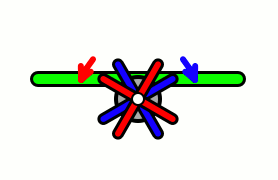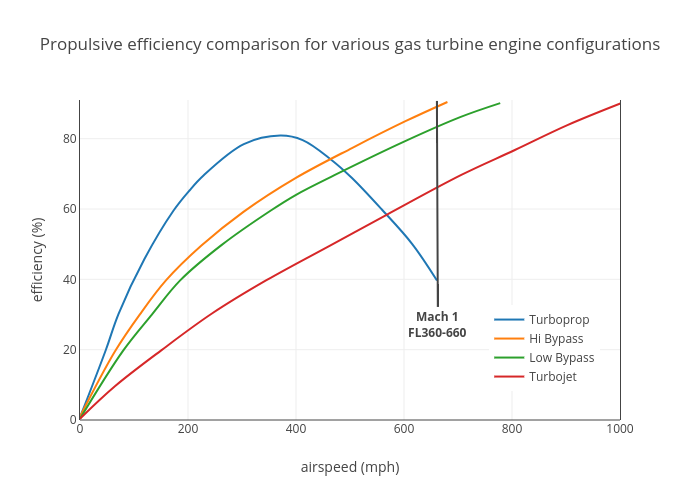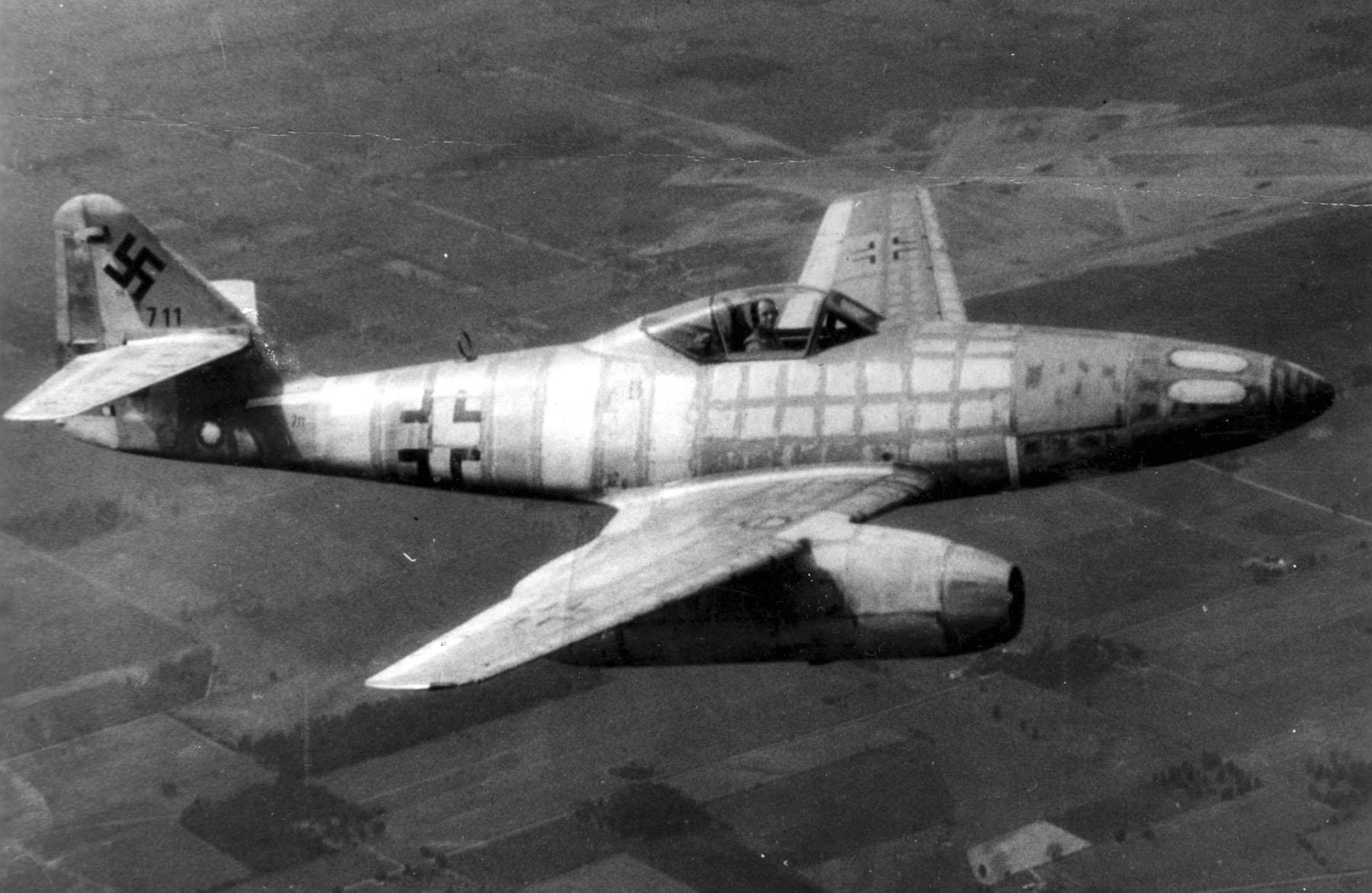|
Propfan
A propfan, also called an open rotor engine, or unducted fan (as opposed to a ducted fan), is a type of aircraft engine related in concept to both the turboprop and turbofan, but distinct from both. The design is intended to offer the speed and performance of a turbofan, with the fuel economy of a turboprop. A propfan is typically designed with a large number of short, highly twisted blades, similar to the Ducted fan, (ducted) fan in a turbofan engine. For this reason, the propfan has been variously described as an "unducted fan" (UDF) or an "ultra-high-bypass (UHB) turbofan." Definition In the 1970s, Hamilton Standard described its propfan as "a small diameter, highly loaded multiple bladed variable pitch propulsor having swept blades with thin advanced airfoil sections, integrated with a nacelle contoured to retard the airflow through the blades thereby reducing compressibility losses and designed to operate with a turbine engine and using a single stage reduction gear ... [...More Info...] [...Related Items...] OR: [Wikipedia] [Google] [Baidu] |
578-DX (on Testbed)
The Pratt & Whitney/Allison 578-DX was an experimental aircraft engine, a hybrid between a turbofan and a turboprop known as a propfan. The engine was designed in the 1980s to power proposed propfan aircraft such as the Boeing 7J7 and the MD-91 and MD-92 derivatives of the McDonnell Douglas MD-80. As of 2019, it is still one of only four different contra-rotating propfan engines to have flown in service or in flight testing. Development The Allison Engine Company, a division of automobile manufacturer General Motors (GM), unveiled its Model 578 contra-rotating propfan engine at the Paris Air Show in mid-1985. The engine represented Allison's attempt to re-enter the commercial airline engine market, because after turboprop aircraft were overtaken in civil aviation in the 1950s and 1960s, Allison was mostly confined to selling military aircraft engines. Targeted to power passenger airliners seating between 100 and 160 passengers, the engine would be based on the core of the All ... [...More Info...] [...Related Items...] OR: [Wikipedia] [Google] [Baidu] |
Turbofan
The turbofan or fanjet is a type of airbreathing jet engine that is widely used in aircraft propulsion. The word "turbofan" is a portmanteau of "turbine" and "fan": the ''turbo'' portion refers to a gas turbine engine which achieves mechanical energy from combustion, and the ''fan'', a ducted fan that uses the mechanical energy from the gas turbine to force air rearwards. Thus, whereas all the air taken in by a turbojet passes through the combustion chamber and turbines, in a turbofan some of that air bypasses these components. A turbofan thus can be thought of as a turbojet being used to drive a ducted fan, with both of these contributing to the thrust. The ratio of the mass-flow of air bypassing the engine core to the mass-flow of air passing through the core is referred to as the bypass ratio. The engine produces thrust through a combination of these two portions working together; engines that use more jet thrust relative to fan thrust are known as ''low-bypass turbofans'', ... [...More Info...] [...Related Items...] OR: [Wikipedia] [Google] [Baidu] |
Contra-rotating Propeller
Aircraft equipped with contra-rotating propellers, also referred to as CRP, coaxial contra-rotating propellers, or high-speed propellers, apply the maximum power of usually a single piston or turboprop engine to drive a pair of coaxial propellers in contra-rotation. Two propellers are arranged one behind the other, and power is transferred from the engine via a planetary gear or spur gear transmission. Contra-rotating propellers are also known as counter-rotating propellers, although counter-rotating propellers is much more widely used when referring to airscrews on separate non-coaxial shafts turning in opposite directions. Operation When airspeed is low, the mass of the air flowing through the propeller disk (thrust) causes a significant amount of tangential or rotational air flow to be created by the spinning blades. The energy of this tangential air flow is wasted in a single-propeller design, and causes handling problems at low speed as the air strikes the vertical sta ... [...More Info...] [...Related Items...] OR: [Wikipedia] [Google] [Baidu] |
Turboprop
A turboprop is a turbine engine that drives an aircraft propeller. A turboprop consists of an intake, reduction gearbox, compressor, combustor, turbine, and a propelling nozzle. Air enters the intake and is compressed by the compressor. Fuel is then added to the compressed air in the combustor, where the fuel-air mixture then combusts. The hot combustion gases expand through the turbine stages, generating power at the point of exhaust. Some of the power generated by the turbine is used to drive the compressor and electric generator. The gases are then exhausted from the turbine. In contrast to a turbojet or turbofan, the engine's exhaust gases do not provide enough energy to create significant thrust, since almost all of the engine's power is used to drive the propeller. Technological aspects Exhaust thrust in a turboprop is sacrificed in favor of shaft power, which is obtained by extracting additional power (beyond that necessary to drive the compressor) from turb ... [...More Info...] [...Related Items...] OR: [Wikipedia] [Google] [Baidu] |
Propeller (aircraft)
An aircraft propeller, also called an airscrew,Beaumont, R.A.; ''Aeronautical Engineering'', Odhams, 1942, Chapter 13, "Airscrews". converts rotary motion from an engine or other power source into a swirling slipstream which pushes the propeller forwards or backwards. It comprises a rotating power-driven hub, to which are attached several radial airfoil-section blades such that the whole assembly rotates about a longitudinal axis. The blade pitch may be fixed, manually variable to a few set positions, or of the automatically variable "constant-speed" type. The propeller attaches to the power source's driveshaft either directly or through reduction gearing. Propellers can be made from wood, metal or composite materials. Propellers are most suitable for use at subsonic airspeeds generally below about , although supersonic speeds were achieved in the McDonnell XF-88B experimental propeller-equipped aircraft. Supersonic tip-speeds are used in some aircraft like the Tupolev Tu-95, ... [...More Info...] [...Related Items...] OR: [Wikipedia] [Google] [Baidu] |
Aerospace Engineer
Aerospace engineering is the primary field of engineering concerned with the development of aircraft and spacecraft. It has two major and overlapping branches: aeronautical engineering and astronautical engineering. Avionics engineering is similar, but deals with the electronics side of aerospace engineering. "Aeronautical engineering" was the original term for the field. As flight technology advanced to include vehicles operating in outer space, the broader term " aerospace engineering" has come into use. Aerospace engineering, particularly the astronautics branch, is often colloquially referred to as "rocket science". Overview Flight vehicles are subjected to demanding conditions such as those caused by changes in atmospheric pressure and temperature, with structural loads applied upon vehicle components. Consequently, they are usually the products of various technological and engineering disciplines including aerodynamics, Air propulsion, avionics, materials scienc ... [...More Info...] [...Related Items...] OR: [Wikipedia] [Google] [Baidu] |
Bypass Ratio
The bypass ratio (BPR) of a turbofan engine is the ratio between the mass flow rate of the bypass stream to the mass flow rate entering the core. A 10:1 bypass ratio, for example, means that 10 kg of air passes through the bypass duct for every 1 kg of air passing through the core. Turbofan engines are usually described in terms of BPR, which together with engine pressure ratio, turbine inlet temperature and fan pressure ratio are important design parameters. In addition, BPR is quoted for turboprop and unducted fan installations because their high propulsive efficiency gives them the overall efficiency characteristics of very high bypass turbofans. This allows them to be shown together with turbofans on plots which show trends of reducing specific fuel consumption (SFC) with increasing BPR. BPR is also quoted for lift fan installations where the fan airflow is remote from the engine and doesn't physically touch the engine core. Bypass provides a lower fuel consumption ... [...More Info...] [...Related Items...] OR: [Wikipedia] [Google] [Baidu] |
Mach Number
Mach number (M or Ma) (; ) is a dimensionless quantity in fluid dynamics representing the ratio of flow velocity past a boundary to the local speed of sound. It is named after the Moravian physicist and philosopher Ernst Mach. : \mathrm = \frac, where: : is the local Mach number, : is the local flow velocity with respect to the boundaries (either internal, such as an object immersed in the flow, or external, like a channel), and : is the speed of sound in the medium, which in air varies with the square root of the thermodynamic temperature. By definition, at Mach1, the local flow velocity is equal to the speed of sound. At Mach0.65, is 65% of the speed of sound (subsonic), and, at Mach1.35, is 35% faster than the speed of sound (supersonic). Pilots of high-altitude aerospace vehicles use flight Mach number to express a vehicle's true airspeed, but the flow field around a vehicle varies in three dimensions, with corresponding variations in local Mach number. The loc ... [...More Info...] [...Related Items...] OR: [Wikipedia] [Google] [Baidu] |
Cruise Altitude
Altitude or height (also sometimes known as depth) is a distance measurement, usually in the vertical or "up" direction, between a reference datum and a point or object. The exact definition and reference datum varies according to the context (e.g., aviation, geometry, geographical survey, sport, or atmospheric pressure). Although the term ''altitude'' is commonly used to mean the height above sea level of a location, in geography the term elevation is often preferred for this usage. Vertical distance measurements in the "down" direction are commonly referred to as depth. In aviation In aviation, the term altitude can have several meanings, and is always qualified by explicitly adding a modifier (e.g. "true altitude"), or implicitly through the context of the communication. Parties exchanging altitude information must be clear which definition is being used. Aviation altitude is measured using either mean sea level (MSL) or local ground level (above ground level, or ... [...More Info...] [...Related Items...] OR: [Wikipedia] [Google] [Baidu] |
Maquette UDF - Musée Safran (cropped)
A ''maquette'' (French word for scale model, sometimes referred to by the Italian names ''plastico'' or ''modello'') is a scale model or rough draft of an unfinished sculpture. An equivalent term is ''bozzetto'', from the Italian word for "sketch". Sculpture A maquette is used to visualize and test forms and ideas without incurring the expense and effort of producing a full-scale piece. It is the analogue of the painter's cartoon, ''modello'', oil sketch, or drawn sketch. For commissioned works, especially monumental public sculptures, a maquette may be used to show the client how the finished work will relate to its proposed site. The term may also refer to a prototype for a video game, film, or other media. ''Modello'', unlike the other terms, is also used for sketches for two-dimensional works such as paintings. Like oil sketches, these models by highly regarded artists can become as desirable as their completed works, as they show the process of developing an idea. For ... [...More Info...] [...Related Items...] OR: [Wikipedia] [Google] [Baidu] |
Swept Wing
A swept wing is a wing that angles either backward or occasionally Forward-swept wing, forward from its root rather than in a straight sideways direction. Swept wings have been flown since the pioneer days of aviation. Wing sweep at high speeds was first investigated in Germany as early as 1935 by Albert Betz and Adolph Busemann, finding application just before the end of the Second World War. It has the effect of delaying the shock waves and accompanying aerodynamic drag rise caused by fluid compressibility near the speed of sound, improving performance. Swept wings are therefore almost always used on jet aircraft designed to fly at these speeds. The term "swept wing" is normally used to mean "swept back", but variants include forward-swept wing, forward sweep, Variable-sweep wing, variable sweep wings and oblique wings in which one side sweeps forward and the other back. The delta wing is also aerodynamically a form of swept wing. Reasons for sweep There are three main reasons ... [...More Info...] [...Related Items...] OR: [Wikipedia] [Google] [Baidu] |
Gas Turbine
A gas turbine, also called a combustion turbine, is a type of continuous flow internal combustion engine. The main parts common to all gas turbine engines form the power-producing part (known as the gas generator or core) and are, in the direction of flow: * a rotating gas compressor * a combustor * a compressor-driving turbine. Additional components have to be added to the gas generator to suit its application. Common to all is an air inlet but with different configurations to suit the requirements of marine use, land use or flight at speeds varying from stationary to supersonic. A propelling nozzle is added to produce thrust for flight. An extra turbine is added to drive a propeller ( turboprop) or ducted fan (turbofan) to reduce fuel consumption (by increasing propulsive efficiency) at subsonic flight speeds. An extra turbine is also required to drive a helicopter rotor or land-vehicle transmission ( turboshaft), marine propeller or electrical generator (power turbine). Grea ... [...More Info...] [...Related Items...] OR: [Wikipedia] [Google] [Baidu] |
.jpg)
.png)





.jpg)


